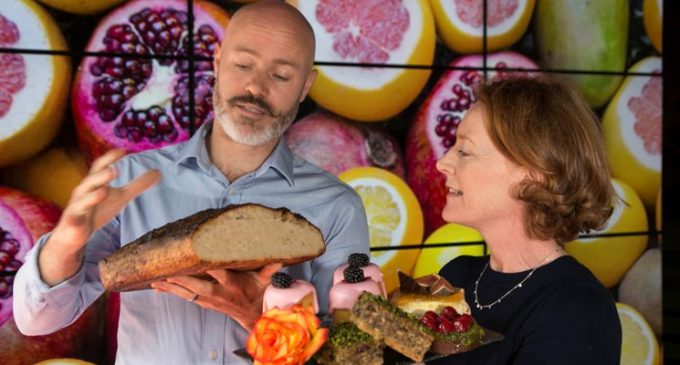New Bord Bia Study Brings High End Culinary Inspiration to Irish Food and Drink Industry

Personalized dishes, tapping trees to flavour water and multi-sensory experiences are just some of the innovations being undertaken by the world’s leading chefs and restaurants according to a new ‘Culinary Inspiration’ magazine launched by Bord Bia. Michelin star chefs and high end restauranteurs from London and Rio de Janeiro to Cape Town, Tokyo and New York participated in the Bord Bia research which aims to better inform Ireland’s food industry on the latest flavours, ingredients and cooking techniques at the leading edge of the culinary world.
Some of the unusual innovations include the use of dream weavers, psychologists and flavour chemists to personalize diners’ meals, a menu containing emojis that impacts the lighting and music selection in the restaurant, edible candles made from beef dripping and tapping birch trees for water to add freshness to dishes.
 The Thinking House, Bord Bia’s Insight Centre, will work with food producers to translate these trends into commercially successful innovations. Commenting on the study, David Deeley of Bord Bia’s Insight Team, said: “This type of research helps Ireland’s food and drink industry to look forward and acts as a catalyst for new thoughts and ideas, providing inspiration for new product development and commercial growth. In Bord Bia, we use consumer trends to inform our thinking, whether that be for new product design, commercial strategy or creating new brands. It is all about being relevant amongst consumers – to quote US Army General, Eric Shinseki – “if you don’t like change, you’re going to like irrelevance even less.”
The Thinking House, Bord Bia’s Insight Centre, will work with food producers to translate these trends into commercially successful innovations. Commenting on the study, David Deeley of Bord Bia’s Insight Team, said: “This type of research helps Ireland’s food and drink industry to look forward and acts as a catalyst for new thoughts and ideas, providing inspiration for new product development and commercial growth. In Bord Bia, we use consumer trends to inform our thinking, whether that be for new product design, commercial strategy or creating new brands. It is all about being relevant amongst consumers – to quote US Army General, Eric Shinseki – “if you don’t like change, you’re going to like irrelevance even less.”
Bord Bia encourages Irish food and drink producers to understand how these themes are playing out in kitchens all over the globe and to reflect on the findings by asking questions of and probing these emerging trends. David added: “We are exploring culinary trends in cooking style, food preparation, ingredients, flavours, fusion and presentation amongst leading chefs and restaurants around the world to get inspiration for the next big trend. For example, pulled pork emerged onto menus in Austin, Texas in 2008, emerging from the global trend towards smoked and BBQ’d and then went onto grow to global dominance in 2015 where it was on virtually every menu you saw and now today, on most supermarket shelves too.”
What did Bord Bia learn?
Leading Michelin star chefs and restauranteurs are now embracing Nordic-style cuisine, sustainability, seasonality, nostalgia, story-telling, delighting the senses and simplicity. David said: “If we jump back to the early 00’s, you would see that fine dining was all about Molecular Gastronomy with foams, emulsions and science. Fast forward ten years, and we see organic farming, foraging and less cooking starting to emerge with fine dining now seen as accessible to everyone. The Maitre D’ culture is also regressing in place of more engaging, personalised and social experiences by using the environment, theatre and fun, to enhance taste. The world’s leading restaurants are paying closer attention to individual wants and needs, as opposed to dictating exactly what and how their guests will eat.”
Bord Bia today presented the findings to some 100 food and drink brands, who also heard from John Wyer, chef from Dublin’s acclaimed Forest Avenue, a restaurant renowned for its creative and seasonal tasting menus. Through a series of quarterly reports, Bord Bia’s first ‘Culinary Inspiration’ study, identifies four themes at play in the high-end culinary world – all natural, storytelling, adaptive cuisine and beyond taste.
1. All Natural: Constraint breeds creativity
High-end dining used to pride itself on a clinical approach to cooking using ingredients imported from all over the world. Now chefs are making use of ingredients naturally found in their locale and allowing seasonality and natural processes shape their menus. Limiting available ingredients has forced chefs to become more creative, and has led to an increase in foraging, re-using waste through fermentation, and using common ingredients in ways that are unexpected. Some global examples of this include:
- Restaurant Relae, Copenhagen, is the only fully organic Michelin-star restaurant in the world, using products from its own farm. They have created a beetroot steak using monster red beets, which are baked overnight to achieve the colour and consistency of a rare steak. The restaurant is also using birch trees (abundant in Denmark), tapping them for water to add sweetness and freshness to some of their dishes.
- Blue Hill restaurant, New York, roast their legs of lamb over lamb femurs, carbonising the leftover bones to infuse more flavour in the cooking process and reduce waste.
- Virgilio Martinez, a chef from Centrale Restaurant, Lima, is experimenting with the effect of altitude on flavour, baking potatoes in a traditional Peruvian ‘huatia’ soil oven in different locations, giving different degrees of woodiness and saltiness to baked potatoes.
2. Storytelling: The personality behind the plate
Articulating your ‘story’ sees high end chefs drawing on the past to create dishes that can stand the test of time. Leading chefs are drawing on their own history and their heritage to present contemporary dishes that are inspired by nostalgia, provenance, and authenticity. Each element of the plate tells a piece of the story, and as a whole the plate is a reflection of the chef’s roots. Some restaurants leading the way include:
- Restaurant Story in London gives a nod to the past by placing a candle in the middle of the table made from beef dripping. The candle is lit and as it melts, diners dip the accompanying sourdough bread in the salty, melted beef fat.
- Chef Jan Hendrik van der Westhuizen of Restaurant Jan in Nice says that, “Food has a soul, a story and that is part of a traceable tradition. A new trend in restaurants is for the chefs to be more hands on and in the front. Taking the plates out and describing where it comes from.”
- Diners wouldn’t naturally associate mould with fine dining; however, in Noma in Copenhagen they have a flavour chemist on hand to bring traditional tangy and acidic flavours to their contemporary dishes through the use of climate-controlled incubators.
3. Adaptive Cuisine: Diner-centric dishes
As culinary technology advances, chefs are able to precisely control every element of the cooking process to ensure the ‘perfect’ plate. Precision, paired with personalisation, is being used to optimise diner experience for every individual in the restaurant. The world’s leading chefs and restaurants are paying closer attention to individual diner wants and needs, as opposed to dictating what and how their guests will eat seen in traditional dining practices. This culinary trend gives diners the opportunity to take control of their own experience making it more of an active process.
- Epitomising futuristic dining, Spain’s Food Ink is the world’s first ever restaurant to focus on 3D printing. Printing everything from the cutlery to the food, the chefs create intricate tailored designs for their diners, which can be personalised easily and quickly.
- The world’s best restaurant for 2017, New York’s Eleven Madison Park have employed ‘dream weavers’ in their restaurant to listen in to their guests’ conversations, which the chefs then cleverly integrate into the dishes they serve.
- How would you like your steak? The French Laundry in California have taken this question to the next level by offering sous – vide cooking which facilitates extreme temperature precision. This enables chefs to exact their cooking of meat and seafood, offering 24 options between ‘rare’ and ‘well done’.
- Ever been unsure of what you’re eating? Sushi Taku in Tokyo, Japan accompany every dish with a physical encyclopaedia, enabling diners to delight in researching the obscure and exotic ingredients the menu offers
- If it’s a dark, cold, dreary day, the chefs at the The Finch in New York will serve more warming, wholesome dishes than on a brighter day. Through menu flexibility, this tailoring method ensures that diners get a personalised, relatable experience, and tastes that fit their current surroundings.
- Sublimotion in Ibiza takes personalisation to the extreme with their dessert course, with the diner constructing their own dessert from the dessert bar. This encourages flavour experimentation and leaves the diner in charge!
4. Beyond Taste: Playing with perception to delight the senses
The report found that cuisine cannot be separated from the dining environment in which it is served. To this end, many leading chefs are embracing a 360 degree dining opportunity. Moving beyond taste to stimulating other senses, they are creating surprising ‘share-worthy’ culinary pieces which engage the imagination and stimulate the senses. In more and more high end settings this food experience feels almost like theatre or art.
- According to Tom Sellers, Head Chef at Michelin-starred London’s Restaurant Story “in terms of a dining experience, people are now looking for multi-sensory. Chefs are going beyond the food – thinking about sound, temperature, smell, art, culture, daylight, so many things. It is really brave ground to tread, and it hasn’t been taken to the next level it can go to yet.”
- At Kitchen Theory, Jozef Youssef pursues multi-sensory techno-emotional gastronomy, with the help of psychologists. His course of poached langoustine velouté is accompanied by his staff spraying a saffron scent around the diners, to engage the senses beyond taste.
- Meanwhile Gaggan, based in Bangkok and voted best restaurant in Asia three times, injects a sense of playfulness into its menu, which consists of 25 emojis signifying ‘moods’. The selection is then linked to lighting and music settings.
What does the menu of tomorrow look like?
Bord Bia looked to see what the menu of the future will look like The menu of tomorrow is a collection of some of the breakthrough dishes, flavours, ingredients and techniques shared by the experts. Restaurants of the future will ask diners to complete a short taste profile or personal questionnaire upon making a reservation or to simply speak to the chef on arrival. Questions would focus on; their dietary needs and preferences, where they have been that day, where they spent their favourite holiday, and how they would describe themselves in three words, ultimately creating a customised and more personal dining experience. Restaurants will seek to use diners’ nostalgia to evoke memories and emotions that will remind them of their own history and heritage. Menus will incorporate traditional ingredients presented in contemporary formats, and paired with surprising flavours.
To access the first of the reports themed All Natural, visit www.BordBia.ie/


































